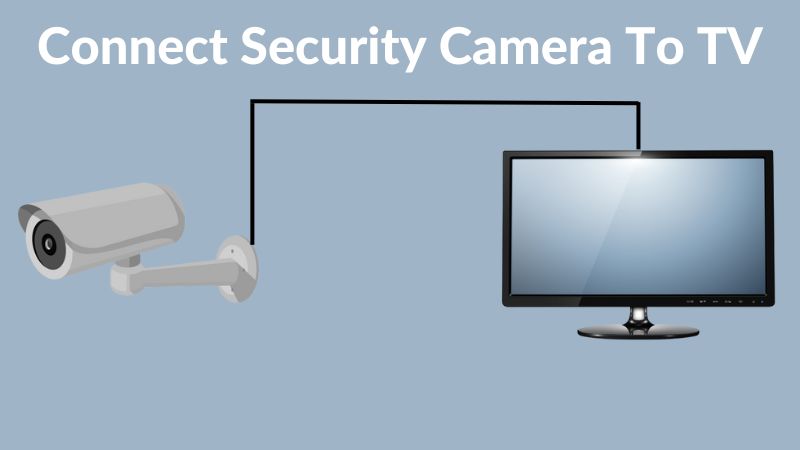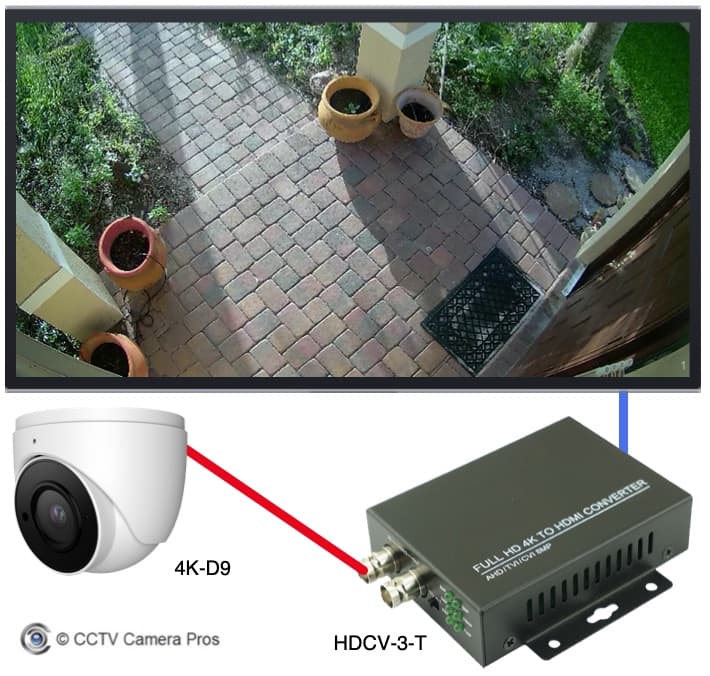Yes, you can connect a CCTV camera directly to a TV. This setup usually requires a compatible connection cable.
Connecting a CCTV camera directly to a TV offers a straightforward way to monitor your space without the complexity of a full surveillance system. This method is particularly appealing for those seeking a simple, cost-effective security solution. With technological advancements, many TVs and CCTV cameras now support direct connections, making it easier than ever to set up.
Whether you’re looking to keep an eye on your home while you’re away or want to monitor a specific area, this setup can be an excellent choice. The key is ensuring your TV and camera are compatible, typically involving HDMI or AV connections. This approach provides real-time surveillance without the need for a DVR or network setup, appealing to users seeking simplicity and efficiency in their security measures.

Credit: cctvcameravision.com
Introduction To Cctv To Tv Connection
Connecting a CCTV camera to a TV allows real-time monitoring. This setup is simple and cost-effective. Users enjoy a live feed from their security cameras on their television screens. This method bypasses complex systems for a straightforward security solution.
Benefits Of Direct Connection
Direct CCTV to TV connection offers clear advantages:
- Easy setup: No need for technical skills.
- Cost savings: Avoids expensive recorders.
- Instant access: Watch live footage quickly.
- High-quality video: Ensures clear images.
Potential Use Cases
A direct CCTV to TV link suits many scenarios:
| Use Case | Benefit |
|---|---|
| Home security | Monitor entrances in real-time. |
| Baby monitoring | Keep an eye on your child. |
| Business surveillance | Watch over your store or office. |
Credit: www.quora.com
Types Of Cctv Cameras
Understanding the types of CCTV cameras helps in making the right choice for your security needs. Let’s explore the two primary types.
Analog Cameras
Analog cameras are traditional CCTV systems. They capture analog video signals and send them to a DVR via coaxial cables. The DVR converts the analog signal to digital, compresses it, and stores it on a hard drive.
- Cost-effective and widely used
- Simple to install and operate
- Lower resolution than digital options
- Requires separate power source
Digital/ip Cameras
Digital cameras, also known as IP cameras, capture and transmit video over a network. They allow for higher resolution footage and can connect to the internet.
- High-resolution images for clearer details
- Power over Ethernet (PoE) simplifies wiring
- Remote viewing on smart devices possible
- Can store data on network video recorders (NVRs) or the cloud
Understanding Tv Inputs
Understanding TV Inputs is key to connecting a CCTV camera. Modern TVs feature various input options. These options allow external devices to link to the TV. You can use these inputs for your CCTV setup. Let’s explore the most common inputs like HDMI and AV.
Hdmi Ports
HDMI ports are the standard for high-definition connections. They carry both audio and video signals. With a single cable, you can connect your CCTV camera. Look for the HDMI port on your TV. It’s usually labeled with ‘HDMI’ or a number if multiple ports are available.
- HDMI supports high-quality video.
- It’s a common interface in most modern TVs.
- Connecting is simple and clutter-free.
Av/composite Inputs
AV/Composite inputs are for analog video signals. They use RCA cables for connection. These are the red, white, and yellow plugs. They are common in older TV models.
- Red and white cables are for audio.
- The yellow cable carries video signals.
- This setup may need a BNC to RCA converter for CCTV.
Check your TV’s input options before connecting a camera. Choose the right cable and port for a successful setup.
Cctv To Tv Connection Basics
Connecting a CCTV camera directly to a TV seems complex. It’s not. This guide explains the basics. You’ll learn how to do it step-by-step.
Equipment Needed
- CCTV camera: This captures video.
- TV: To display the video.
- Coaxial cable or HDMI cable: For connection.
- Power adapter: For the camera.
- BNC to HDMI converter (if needed): Converts camera output to TV input.
Step-by-step Connection Process
- Power off your TV and CCTV camera.
- Connect the CCTV camera to the power adapter.
- Use the coaxial cable or HDMI cable to connect the camera to the TV. If your camera outputs in BNC, use a BNC to HDMI converter.
- Turn on the TV and select the right input channel.
- Power on the CCTV camera.
- You should now see the camera’s video on your TV.
Troubleshooting Common Issues
Many people try to connect a CCTV camera directly to their TV. Sometimes, they face issues. Let’s solve these common problems together.
Signal Compatibility Problems
Not all TVs and cameras work well together. Here’s what to do:
- Check the camera output. It must match your TV’s input.
- Use a converter. This changes the camera signal to fit your TV.
- Update your TV’s firmware. Sometimes, this fixes the problem.
Image Quality Concerns
Poor image quality can be frustrating. Improve it by following these steps:
- Adjust the camera’s settings. Look for clarity options.
- Check the cable quality. Use high-quality cables for better images.
- Reduce the distance. A shorter cable length can improve quality.
| Issue | Solution |
|---|---|
| No Signal | Check connections and power supply. |
| Fuzzy Image | Adjust focus and clean the lens. |
Remember, fixing these issues often involves trial and error. Don’t give up!
Alternatives To Direct Connection
Directly connecting a CCTV camera to a TV is straightforward, but limitations exist. Alternatives offer flexibility and enhanced features. Explore these options for a more robust surveillance setup.
Using A Dvr Or Nvr
Digital Video Recorders (DVRs) and Network Video Recorders (NVRs) act as middlemen between CCTV cameras and TVs. They offer:
- Storage: Record and save footage for later review.
- Multiple Cameras: Connect several cameras, view on one screen.
- Remote Access: Watch live feeds via internet-connected devices.
Streaming Over A Network
Modern CCTV systems can stream video over a network. This allows for:
- Easy Access: View your camera feed on any networked device.
- Flexibility: No need for direct connections to a TV.
- Scalability: Add more cameras without extra hardware.
Enhancing Your Security Setup
Enhancing Your Security Setup with a CCTV system brings peace of mind. A common question is whether a CCTV camera can link directly to a TV. The answer is yes. This setup provides real-time surveillance without a computer or separate monitor. We’ll explore how to add multiple cameras and use smart TV features to maximize security.
Adding Multiple Cameras
Multiple cameras cover more areas. This gives better protection for your home or business. Most modern TVs have several input ports. You can connect more than one camera to your TV. Use an HDMI splitter or an input switcher for more cameras. This allows you to view different angles on one screen or switch between them.
- Check your TV’s input ports.
- Get an HDMI splitter for more cameras.
- Use a switcher to toggle between views.
Incorporating Smart Tv Features
Smart TVs have built-in apps and internet connectivity. This makes your security system smarter. Connect your camera with a smart TV. Use apps to control camera views. Get notifications on your TV when there’s movement. Record footage straight to your TV’s hard drive.
| Feature | Benefit |
|---|---|
| Apps | Control cameras easily |
| Internet | Get updates and notifications |
| Recording | Save footage on TV |
Legal And Privacy Considerations
Before connecting a CCTV camera to a TV, consider legal and privacy issues. This ensures you respect others’ rights and follow the law.
Understanding Surveillance Laws
Surveillance laws vary by location. Always check local regulations before setting up CCTV cameras. Some areas may require signage or consent from people in the camera’s view. Ignoring these laws can lead to serious consequences.
Ensuring Privacy Compliance
Respect privacy when installing cameras. Only capture public or your own property areas. Avoid pointing cameras at neighbors’ homes or private spaces. This helps prevent disputes and maintains good relations with others.
- Review local surveillance laws
- Get consent if needed
- Place signs to inform of CCTV
- Avoid private spaces of others
- Keep footage secure

Credit: www.cctvcamerapros.com
Frequently Asked Questions
Can Cctv Cameras Link To Tvs Directly?
Yes, many CCTV cameras can connect directly to a TV using an HDMI or AV input.
What’s Required To Connect Cctv To Tv?
To connect CCTV to a TV, you’ll need a compatible CCTV camera, a TV with an HDMI or AV input, and a cable.
Does Connecting Cctv To Tv Need Expert Help?
Simple connections often don’t require expert help, but for complex setups or hidden wiring, professional installation is recommended.
Will Any Tv Work With Cctv Cameras?
Most modern TVs with HDMI or AV inputs can display footage from CCTV cameras.
Can Wireless Cctv Connect To Smart Tvs?
Yes, wireless CCTV cameras can connect to smart TVs through Wi-Fi or a dedicated app provided by the camera manufacturer.
Conclusion
Connecting your CCTV camera to your TV can be a straightforward process. With the right equipment and simple steps, you can enhance home security and monitor your space with ease. Remember, compatibility and correct cabling are key. For personalized advice, consider consulting a professional.
Embrace this tech-savvy method for peace of mind and effective surveillance.




